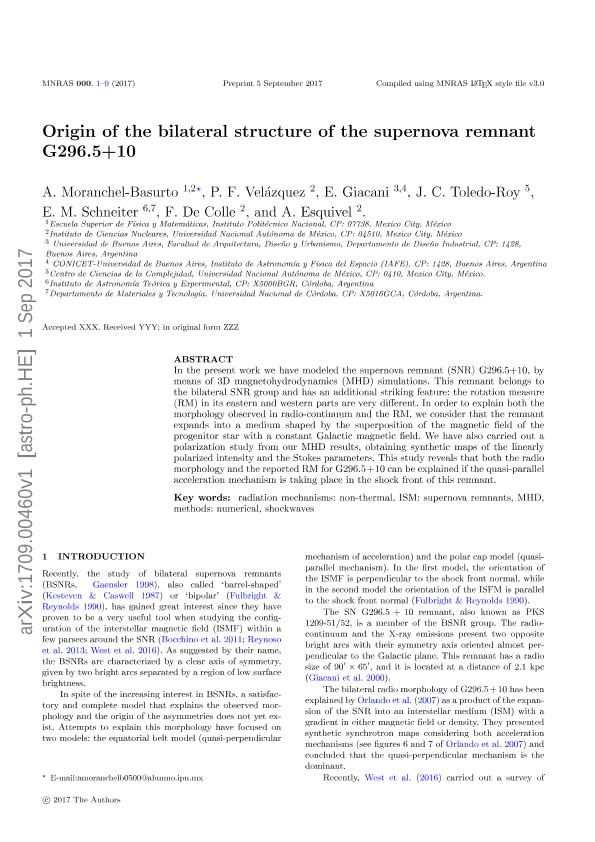Mostrar el registro sencillo del ítem
dc.contributor.author
Moranchel-Basurto, A.
dc.contributor.author
Velazquez, P.
dc.contributor.author
Giacani, Elsa Beatriz

dc.contributor.author
Toledo Roy, J. C.
dc.contributor.author
Schneiter, E.
dc.contributor.author
De Colle, F.
dc.contributor.author
Esquivel, A.
dc.date.available
2017-12-05T14:03:17Z
dc.date.issued
2017-08-14
dc.identifier.citation
Moranchel-Basurto, A.; Velazquez, P.; Giacani, Elsa Beatriz; Toledo Roy, J. C.; Schneiter, E.; et al.; Origin of the bilateral structure of the supernova remnant G296.5+10; Oxford University Press; Monthly Notices of the Royal Astronomical Society; 472; 2; 14-8-2017; 2117-2125
dc.identifier.issn
0035-8711
dc.identifier.uri
http://hdl.handle.net/11336/29693
dc.description.abstract
In this work, we have modelled the supernova remnant (SNR) G296.5+10, by means of 3D magnetohydrodynamics (MHD) simulations. This remnant belongs to the bilateral SNR group and has an additional striking feature: the rotation measure (RM) in its eastern and western parts are very different. In order to explain both the morphology observed in radio-continuum and the RM, we consider that the remnant expands into a medium shaped by the superposition of the magnetic field of the progenitor star with a constant Galactic magnetic field. We have also carried out a polarization study from our MHD results, obtaining synthetic maps of the linearly polarized intensity and the Stokes parameters. This study reveals that both the radio morphology and the reported RM for G296.5+10 can be explained if the quasi-parallel acceleration mechanism is taking place in the shock front of this remnant.
dc.format
application/pdf
dc.language.iso
eng
dc.publisher
Oxford University Press

dc.rights
info:eu-repo/semantics/openAccess
dc.rights.uri
https://creativecommons.org/licenses/by-nc-sa/2.5/ar/
dc.subject
Radiation Mechanisms:Non-Thermal
dc.subject
Supernova Remnants
dc.subject
Mhd, Methods:Numerical
dc.subject
Shock Waves
dc.subject.classification
Astronomía

dc.subject.classification
Ciencias Físicas

dc.subject.classification
CIENCIAS NATURALES Y EXACTAS

dc.title
Origin of the bilateral structure of the supernova remnant G296.5+10
dc.type
info:eu-repo/semantics/article
dc.type
info:ar-repo/semantics/artículo
dc.type
info:eu-repo/semantics/publishedVersion
dc.date.updated
2017-12-04T18:25:21Z
dc.journal.volume
472
dc.journal.number
2
dc.journal.pagination
2117-2125
dc.journal.pais
Reino Unido

dc.journal.ciudad
Londres
dc.description.fil
Fil: Moranchel-Basurto, A.. Universidad Nacional Autónoma de México; México
dc.description.fil
Fil: Velazquez, P.. Universidad Nacional Autónoma de México; México
dc.description.fil
Fil: Giacani, Elsa Beatriz. Universidad de Buenos Aires. Facultad de Arquitectura y Urbanismo; Argentina. Consejo Nacional de Investigaciónes Científicas y Técnicas. Oficina de Coordinación Administrativa Ciudad Universitaria. Instituto de Astronomía y Física del Espacio. - Universidad de Buenos Aires. Facultad de Ciencias Exactas y Naturales. Instituto de Astronomía y Física del Espacio; Argentina
dc.description.fil
Fil: Toledo Roy, J. C.. Universidad Nacional Autónoma de México; México
dc.description.fil
Fil: Schneiter, E.. Universidad Nacional Autónoma de México; México
dc.description.fil
Fil: De Colle, F.. Universidad Nacional Autónoma de México; México
dc.description.fil
Fil: Esquivel, A.. Universidad Nacional Autónoma de México; México
dc.journal.title
Monthly Notices of the Royal Astronomical Society

dc.relation.alternativeid
info:eu-repo/semantics/altIdentifier/url/https://academic.oup.com/mnras/article-abstract/472/2/2117/4082238?redirectedFrom=fulltext
dc.relation.alternativeid
info:eu-repo/semantics/altIdentifier/doi/http://dx.doi.org/10.1093/mnras/stx2086
Archivos asociados
